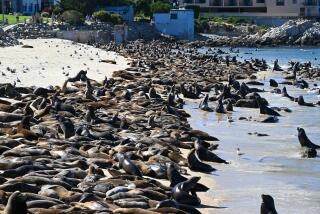Last of Golden Eagles Leave Island
- Share via
For years, in their efforts to restore the Channel Islands ecosystem, scientists have been working hard to bring bald eagles back.
For years, as part of the same effort, they’ve been trying to get golden eagles to leave.
Last week, not long after scientists celebrated the first bald eagle chicks hatched without human aid on Santa Cruz Island in more than half a century, experts hunting in a helicopter used a net gun to remove the last three golden eagles from the island.
One was a 7-week-old chick still in its nest. The others, captured in midflight, were a pair of adults -- possibly the same ones that eluded trappers who tried to pick them up in 2005.
These wily eagles eat feral pigs, which scientists are also trying to remove. But the eagles also are suspected in the death of 20 island foxes, which scientists are desperately trying to save. A search of the nest uncovered the remains of 12 wild foxes -- several without radio collars, which help biologists track the cat-sized creatures on the 96-square-mile island.
Removal of the golden eagles is one part of a four-part plan to restore the island’s ecosystem. The other parts of the plan are the reestablishment of bald eagles, which are larger and prefer fish, smaller birds and nonterrestrial prey; the removal of feral pigs; and the restoration of the population of island foxes.
The two eagles captured last week “posed an extreme threat to the foxes,” said Yvonne Menard, spokeswoman for the National Park Service, which controls nearly a quarter of the island. “We’re optimistic that saving the island fox will be possible with the removal of these nonnative predators.”
The adults were released on the far side of the Sierra Nevada mountains. The golden eagle chick was placed in a raptor center in San Diego and is expected to begin flying as early as this weekend.
Biologists said one or two adolescent golden eagles have been spotted on Santa Cruz in recent months, but it was unclear whether they lived there or were just visiting, Menard said. Monitors will continue to be on the lookout for additional golden eagles, she said.
Since 1999, the park service and the Nature Conservancy -- joint owners of Santa Cruz, about 18 miles off the Ventura County coast -- have spent more than $1.7 million to remove the golden eagles.
Golden eagles first came to the island in the early 1990s to feed on feral pigs, which are descendants of pigs introduced to the island by ranchers in the 1850s. To date, hunters under contract to the park service and Nature Conservancy have killed 5,000 pigs, or as much as 95% of the estimated population.
Lotus Vermeer, the Nature Conservancy’s Santa Cruz Island project director, said the effort to make the golden eagle feel unwelcome has worked. One key part of it is bringing back bald eagles, which do not coexist well with them.
“We’ve made the island very inhospitable for the golden eagles. We’ve taken away their primary food source, which are the feral piglets,” Vermeer said. “This isn’t to say that we won’t have other golden eagles come to the island, but we’ve ... reintroduced another predator to the island, which will compete with them for space.”
Bald eagles, Vermeer said, “are very, very territorial” and tend to dominate when competing for feeding and nesting area.
In the last five years, a captive-breeding program for island foxes has produced 75 pups, Vermeer said.
In May, the last of 58 bald eagles born at the San Francisco Zoo since 2002 were brought to Santa Cruz to learn to fly and become familiar with the island. The program is credited with the hatching of two bald eagle chicks on Santa Cruz this season.
Although it can’t be confirmed, Vermeer said that the female golden eagle captured last week may have been one left alone when a male was captured last year on nearby Santa Rosa Island. Although females usually relocate when a mate is no longer available, it appears this golden eagle bucked the trend and took up with a new male during this mating season, which is winding down.
More to Read
Sign up for Essential California
The most important California stories and recommendations in your inbox every morning.
You may occasionally receive promotional content from the Los Angeles Times.










